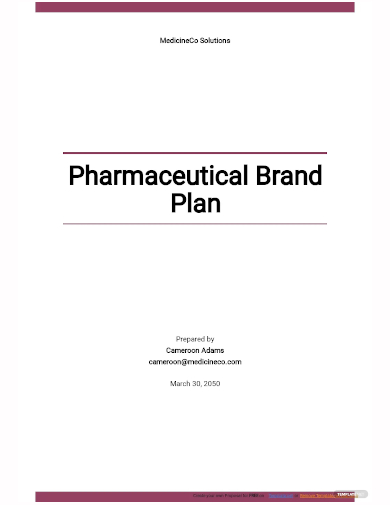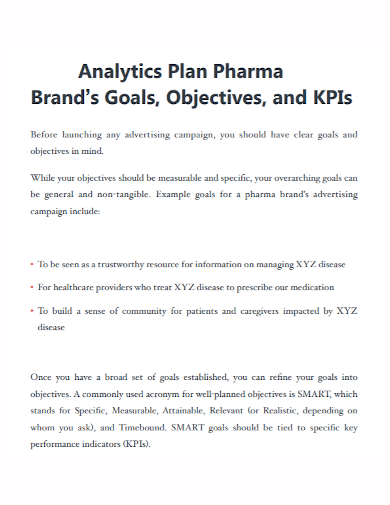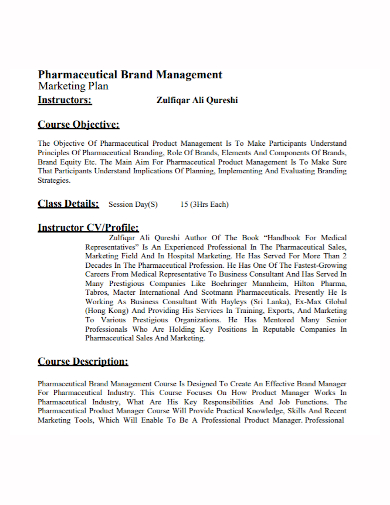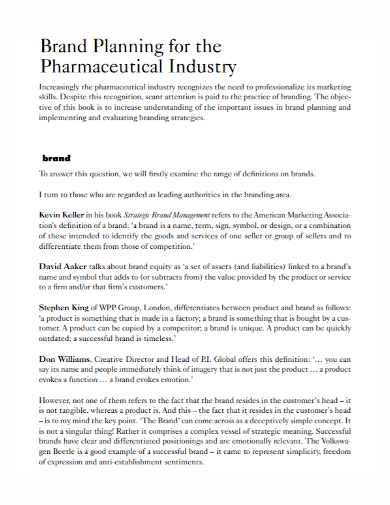The pharmaceutical industry is in charge of discovering, developing, producing, and marketing drugs or pharmaceutical drugs for use as medications to be administered to patients to cure them, vaccinate them or address their symptoms. Pharmaceutical companies manufacture usually generic or brand medications and medical devices. If they have new medicines or devices they want to release in public or promote their brand to increase sales revenue, they need to create a brand plan to come up with marketing strategies and establish their brand well. Read the article to know how to make a pharmaceutical brand plan.
3+ Pharmaceutical Brand Plan Samples
1. Pharmaceutical Brand Plan Template

2. Pharmaceutical Brand Analytics Plan
3. Pharmaceutical Brand Management Plan
4. Pharmaceutical Industry Brand Plan
What is Brand Planning?
Brand planning is the process of dedicating resources to a strategy meant to achieve a business goal that moves a brand closer to delivering on a future vision.
How to Create a Pharmaceutical Brand Plan
1. Know Your Target Audience
The first stage in developing a successful marketing strategy is to identify your target audience. Gather as much information as you can about your target audience. Get a wide range of demographic, regional, and behavioral information. For example, you need to gather information about their age, their primary sources of information, their daily habits, etc. Reaching healthcare professionals requires effective target marketing. It’s easier to connect and communicate with your target audience if you know more about them.
2. Study the Competition
Perhaps you dislike your competitors and you wish they would just vanish so you can domineer over the market. Even if you despise them, you have to admit that they are probably doing something right. And if you want to be successful, you must pay attention to them and learn from them. There are numerous methods for researching your competitors. You can do it by evaluating their website using a variety of online tools to keep your ears to the ground and assess your own data for comparison.
3. Identify Your Goals
You must set SMART goals (Specific, Measurable, Achievable, Relevant, and Time-based) to effortlessly reach your objectives. Setting precise goals will assist you in being focused and motivated. And if you make them measurable, you’ll be able to stay on top of your goals and track your progress at all times. However, you must be practical and set goals that you can reach. Setting goals you can’t reach, on the other hand, means you’ll be wasting your time and resources on something you won’t be able to achieve. Ensure that your goals are relevant by ensuring that they are not just important, but also aligned with your company’s other objectives. It’s also vital to maintain your goals time-based when it comes to monitoring your achievement. This will keep you in sync with the rest of your marketing team, and it will allow you to track your progress over time.
4. Set Up a Budget
Of course, you are determined about achieving your objectives. However, without a budget, you’ll have a hard time accomplishing them. For your marketing strategy to work, you’ll need a pre-determined budget resource. You can choose from a variety of budgeting options. Simply set aside a percentage of a pharmaceutical company’s overall budget for marketing. Or create a separate budget for each goal and task. Your budget can be based on the estimated return on investment or on your personal estimation of how much money you require.
5. Make a Marketing System
It’s time to set up your marketing system now that you’ve finalized your budget and investments. Or, to put it another way, figure out who is in control of what. To ensure that your brand strategy is carried out successfully, you’ll need to figure out who’s doing what and when.
FAQs
What are some challenges in pharmaceutical brand planning?
Some examples of challenges that will happen in pharmaceutical brand planning include not having the right insights and deliverables, the planning process being vague and disorganized, and the organizational culture of a certain pharmaceutical brand having a big lack of cohesiveness.
What are the four branding strategies?
The four branding strategies used by companies are line extension, brand extension, new brand strategy, and fight brand strategy.
What are the biggest pharmaceutical brands?
The biggest pharmaceutical companies in the world are Pfizer, GlaxoSmithKline, Sanofi, AstraZeneca, Roche, Johnson & Johnson, Novartis, Merck & Co., Unilever, Wyeth, Bayer, and Amgen.
Writing a brand plan is meticulous work that you need to commit some time to do your research before you complete it. However, it serves you well by referring to it as a guide map on how to market your pharma’s brand, products, and services you offer. So take your time in creating the plan. Ensure that your plan is written clearly and concisely, and should be free from errors. To help you get started on making a pharmaceutical brand plan, download our free sample templates provided above!
Related Posts
FREE 9+ 30-Day Marketing Plan Samples in PDF | MS Word | Apple Pages | Google Docs
FREE 3+ Sales Team Action Plan Samples in PDF | MS Word | Apple Pages | Google Docs
Marketing Plan For Small Business Samples
FREE 7+ Fashion Business Plan Samples in PDF
FREE 10+ Sprint Planning Samples In MS Word | Google Docs | PDF
FREE 10+ Wedding Planning Samples in MS Word | Apple Pages | Powerpoint | PDF
FREE 9+ Monthly Study Planner Samples in PSD | Illustrator | InDesign | PDF
FREE 9+ Sample Curriculum Planning Templates in PDF | MS Word
FREE 10+ Teacher Development Plan Samples in MS Word | Google Docs | Apple Pages | PDF
FREE 10+ Basketball Practice Plan Samples in PDF
FREE 12+ School Business Plan Samples in PDF | MS Word | Apple Pages | Google Docs
FREE 7+ Client Strategic Plan Samples in PDF | MS Word
FREE 11+ Trucking Business Plan Templates in PDF | MS Word | Google Docs | Pages
FREE 7+ Small Hotel Business Plan Samples PDF | MS Word | Apple Pages | Google Docs
FREE 14+ Bakery Business Plans in MS Word | PDF | Google Docs | Pages



